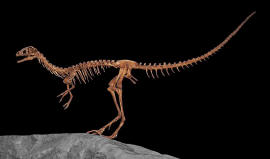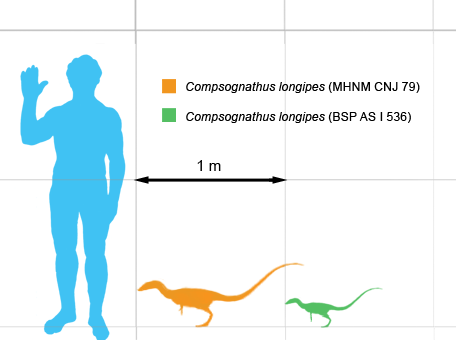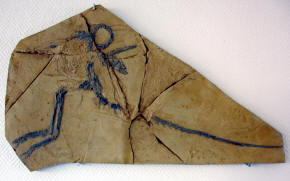|
Many presentations still describe
Compsognathus as a
"chicken-sized" dinosaur because of the small size of the German specimen,
which is now believed to be a juvenile form of the larger French specimen.
Compsognathus is
one of the few dinosaurs for which the diet is known with certainty: the
remains of small, agile lizards are preserved in the bellies of both
specimens. Teeth discovered in Portugal may be further fossil remains of the
genus.
Although not recognized as such at
the time of its discovery, Compsognathus
is the first dinosaur known from a reasonably complete skeleton. Until the
1980s and 1990s, Compsognathus
was the smallest known dinosaur and the closest supposed relative of the
early bird
Archaeopteryx. Thus,
the genus is one of the few dinosaur genera to be well known outside of
paleontological circles.
Description
For decades,
Compsognathus was famed as
the smallest dinosaur known; the specimens collected were around 1 meter (3 ft) in length. However, dinosaurs
discovered later, such as
Caenagnathasia,
Microraptor and
Parvicursor, were even
smaller. The largest Compsognathus
specimen is estimated to have weighed somewhere between 0.83 and 3.5 kg
(between 1.8 and 7.7 lb).
Compsognathus
was a small, bipedal animal with long hind legs and a longer tail, which it
used for balance during locomotion. The forelimbs were smaller than the
hindlimbs and featured three digits equipped with solid claws suited for
grasping prey. Its delicate skull was narrow and long, with a tapered snout.
The skull had five pairs of
fenestrae (skull
openings), the largest of which was for the
orbit (eye socket). The
eyes were large in proportion to the rest of the skull.
The lower jaw was slender and had no
mandibular fenestra, a hole in the lower jawbone commonly seen in
archosaurs. The teeth
were small but sharp, suited for its diet of small vertebrates and possibly
other small animals, such as insects. Its frontmost teeth (those on the
premaxilla) were
unserrated, unlike those further back in the jaw. Scientists have used these
dental characteristics to identify
Compsognathus and its closest relatives.
Discovery and Species
Compsognathus
is known from two nearly complete skeletons, one from Germany that is
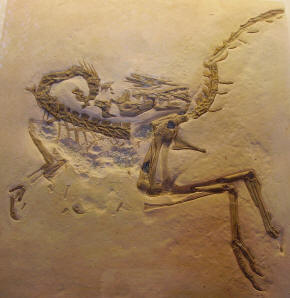 |
| Joseph Oberndorfer discovered this fossil
in Bavaria, Germany, in the 1850s. Shown here is a cast at the
Oxford University Museum of Natural History. (Picture
Source) |
89 cm
long (35 in) and another from France that is 125 cm (49 in). The physician
and fossil collector Joseph Oberndorfer discovered the German specimen (BSP
AS I 563) in the
Solnhofen lithographic
limestone deposits in
the Riedenburg-Kelheim region of
Bavaria during the
1850s. The limestone of the Solnhofen area has also yielded such
well-preserved fossils as
Archaeopteryx with
feather impressions and some
pterosaurs with
imprints of their wing membranes that are dated to the lower
Tithonian age. Johann A. Wagner
discussed the specimen briefly in 1859, when he coined the name
Compsognathus longipes,
and described it in detail in 1861. In early 1868, Thomas Huxley compared
the two species and concluded that, apart from its arms and feathers, the
Archaeopteryx
skeleton was closely similar to Compsognathus,
and that the proto-bird was related to the dinosaurs. In 1896,
Othniel Marsh
recognized the fossil as a true member of the Dinosauria.
John Ostrom thoroughly
redescribed the species in 1978, making it one of the best-known small
theropods at that time. The German specimen is on display at the Bayerische
Staatsammlung für Paläontologie und historische Geologie (Bavarian State
Institute for Paleontology and Historical Geology) in Munich, Germany.
The larger French specimen (MNHN CNJ
79) was discovered in 1972 in the Portlandian lithographic limestone of Canjuers near Nice in southeastern
France. It dates to the lower Tithonian. Although Bidar originally described
the specimen as a separate species called
Compsognathus corallestris, Michard and others
have since relabeled it as another example of
Compsognathus longipes. Quimby identified the
smaller German specimen as a juvenile of the same species. In 1983, the
Muséum national d'histoire naturelle
in Paris acquired the French
Compsognathus
fossil; Michard thoroughly studied it there. Scientists originally
identified a partial foot, also from Solnhofen, as belonging to a
Compsognathus, but later
research has disproved this. Zinke has assigned teeth from the Kimmeridgian
Guimarota formation of
Portugal to the genus.
Classification
Compsognathus
gives its name to the family
Compsognathidae, a
group composed mostly of small dinosaurs from the late Jurassic and early
Cretaceous periods of
China, Europe and South America. For many years it was the only member
known; however in recent decades paleontologists have discovered several
related genera. The
clade includes
Aristosuchus,
Huaxiagnathus,
Mirischia,
Sinosauropteryx, and
perhaps
Juravenator and
Scipionyx.
The position of Compsognathus
and its relatives within the
coelurosaur group is
uncertain. Some, such as theropod expert Thomas Holtz Jr. and
co-authors Ralph Molnar and Phil Currie in the
landmark 2004 text
Dinosauria,
hold the family as the basalmost of the coelurosaurs, while others as part
of the
Maniraptora.
Paleoecology
During the late Jurassic, Europe was
a dry, tropical
archipelago at the edge
of the
Tethys Sea. The fine
limestone in which the skeletons of
Compsognathus have been found originated in
calcite from the shells
of marine organisms. Both the Solnhofen and Canjuers area where
Compsognathus has been
preserved were lagoons situated between the beaches and coral reefs of the
Jurassic European islands in the Tethys Sea. Contemporaries of
Compsognathus include the
early bird
Archaeopteryx and the
pterosaurs
Rhamphorhynchus and
Pterodactylus. The
same sediments in which Compsognathus
has been preserved also contain fossils of a number of marine animals such
as fish, crustaceans, echinoderms and marine mollusks, confirming the
coastal habitat of this theropod. No other dinosaur has been found in
association with Compsognathus,
indicating that this little dinosaur might in fact have been the top land
predator in these islands.
Paleobiology
Hand
The
Compsognathus specimen discovered in Germany in
the 19th century featured only two digits on each forelimb, leading
scientists to conclude that this was how the creature appeared in life.
However, the fossil discovered later in France revealed the manus (hands) to
have had three digits, similar to other members of compsognathid genera. The
fossilization of the German Compsognathus
had simply failed to preserve the specimen's forefeet. Bidar supposed that
the French specimen had webbed forefeet, which would look like flippers in
life. In the 1975 book The Evolution and
Ecology of the Dinosaurs, L. B. Halstead depicts
the animal as an amphibious dinosaur capable of feeding on aquatic prey and
swimming out of reach of larger predators. Ostrom debunked this hypothesis by showing
conclusively that the French specimen was nearly identical to the German
specimen in every aspect but its size. Peyer confirmed these conclusions.
Diet
The remains of a lizard in the
German specimen's thoracic cavity show that
Compsognathus preyed on small vertebrates.
Marsh, who examined the specimen in 1881, thought that this small skeleton
inside Compsognathus
belly was an embryo, but in 1903, Franz Nopcsa concluded
that it was a lizard. Ostrom identified the remains as belonging to a lizard
of the genus
Bavarisaurus, which he
concluded was a fast and agile runner due to its long tail and limb
proportions. This in turn led to the conclusion that its predator,
Compsognathus, must have
had sharp vision and the ability to rapidly accelerate and outrun the
lizard. The Bavarisaurus
is in a single piece, indicating that
Compsognathus must have swallowed its prey
whole. The French specimen's gastric contents consist of unidentified
lizards or
sphenodontids.
Possible Eggs
Excavators discovered eggs 10 mm in
diameter near the fossil remains of the German
Compsognathus. In 1901, Friedrich von Huene
interpreted them as dermal ossifications. Griffiths redescribed them as
immature eggs in 1993. However, later researchers have doubted their
assignment to the genus because they were found outside the body cavity of
the animal. A well-preserved fossil of
Sinosauropteryx, a
genus related to Compsognathus,
shows two
oviducts bearing two
unlaid eggs. These proportionally larger and less numerous eggs of
Sinosauropteryx cast
further doubt on the original identification of the
Compsognathus eggs.
Skin and Connection with Birds
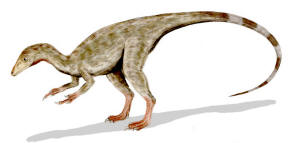 |
| Artist impression of Comspgnathus. Evidence from related
species suggest that the body might have been covered with
feather-like structures. (Picture
Source) |
For nearly a century,
Compsognathus was the only
well-known small theropod. This led to comparisons with
Archaeopteryx and to
suggestions of a relationship with birds. In fact,
Compsognathus, rather than
Archaeopteryx,
piqued Huxley's interest in the origin of birds. The two animals share many
similarities in shape, size and proportions, so many in fact that a
featherless skeleton of an Archaeopteryx
was for many years misidentified as a
Compsognathus. Many other dinosaurs, including
Deinonychus,
Oviraptor and
Segnosaurus, are now
known to have been more closely related to birds.
Some relatives of
Compsognathus, namely
Sinosauropteryx and
Sinocalliopteryx, have
been preserved with the remains of simple feathers covering the body like
fur, promoting some scientists to suggest that
Compsognathus might have been feathered in a
similar way. Consequently, many depictions of
Compsognathus show it with a covering of downy
proto-feathers. However, no feathers or feather-like covering have been
preserved with Compsognathus
fossils, in contrast to Archaeopteryx,
which was found in the same sediments. Karin Peyer, in 2006, reported skin
impressions preserved on the side of the tail starting at the 13th tail
vertebra. The impressions showed small bumpy tubercles, similar to the
scales found on the tail and hind legs of
Juravenator.
Additional scales had earlier been reported by Von Huene, in the abdominal
region of the German Compsognathus,
but Ostrom later disproved this interpretation.
Like
Compsognathus, and unlike
Sinosauropteryx, a patch
of fossilized skin from the tail and hindlimb of the possible relative
Juravenator shows
mainly scales, though there is some indication that simple feathers were
also present in the preserved areas. This may mean that a feather covering
was not ubiquitous in this group of dinosaurs.
In Popular Culture
Children's dinosaur books commonly
feature Compsognathus.
For a long time it was unique in its small size, as most other small
dinosaurs were discovered and described a century or more later.
The animal has appeared in the
movies
The Lost World: Jurassic Park
and
Jurassic Park III. In
The Lost World: Jurassic Park,
one of the characters incorrectly identifies the species as "Compsognathus
triassicus", combining the genus name of
Compsognathus with the
species name of
Procompsognathus, a
distantly related small carnivore featured in the
Jurassic Park novels. The
"compys" are depicted as social animals that hunt in packs which makes them
capable of taking down human-sized prey through overwhelming numbers. This
behavior was invented by the creators of
Jurassic Park as there is indeed no indication
from the fossil record that Compsognathus
(or Procompsognathus)
had such social behavior.
Return to the
Old Earth Ministries Online Dinosaur
Curriculum homepage.

Shopping
|
